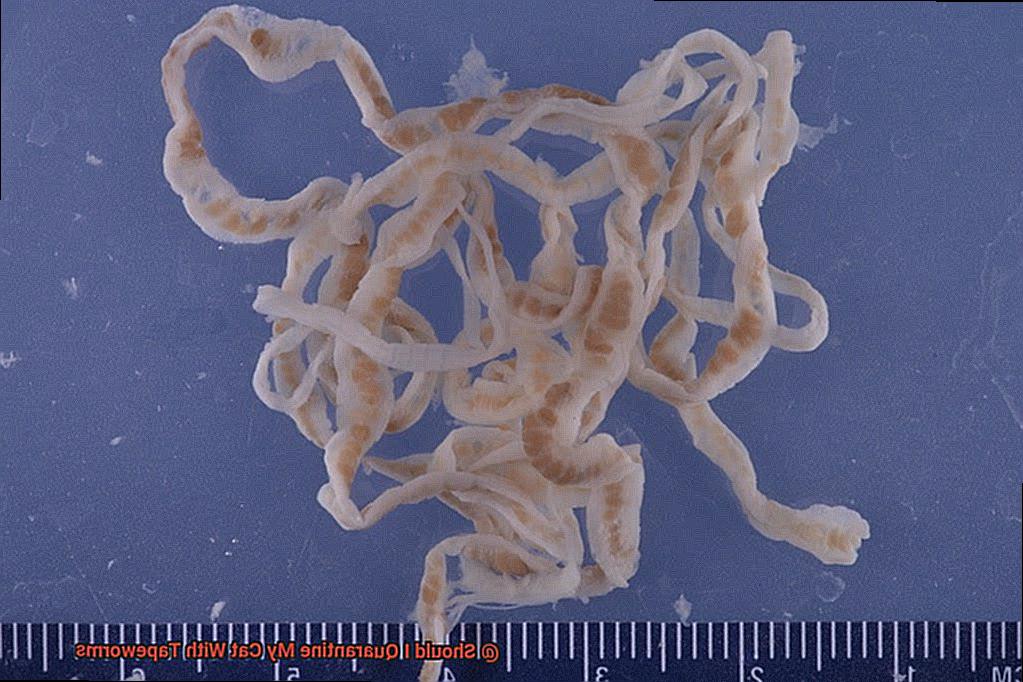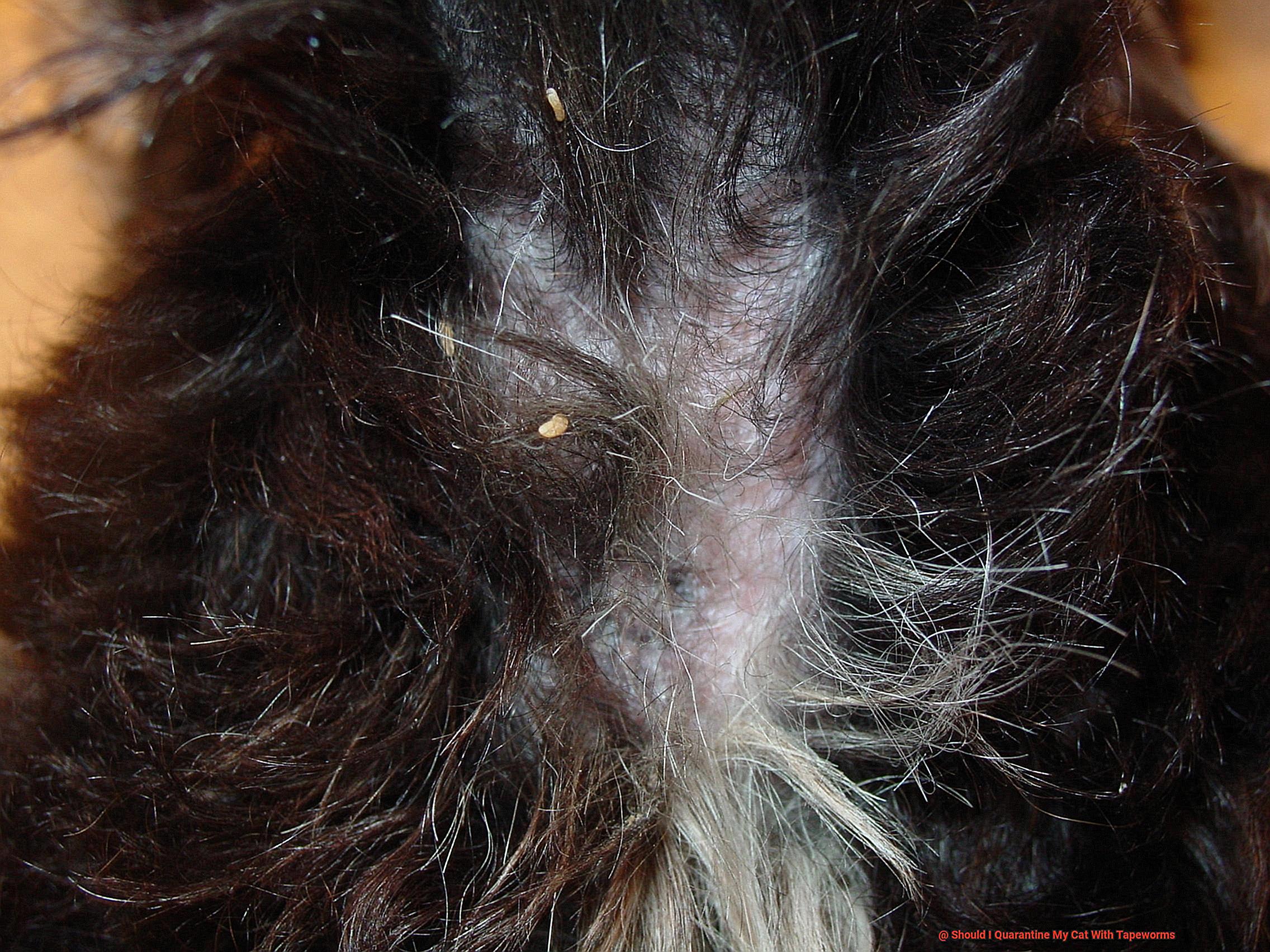As a cat lover, you know that our feline friends are prone to certain health issues. One of the most common is tapeworms – those pesky parasites that can cause a range of symptoms, from weight loss and vomiting to digestive upset and anal irritation. As a responsible pet owner, you want to make sure your furry friend gets the best treatment possible. But what if that means quarantine?
The question of whether to isolate a cat with tapeworms is hotly debated, with passionate arguments on both sides. Some experts say that keeping your cat quarantined during treatment can help prevent the spread of tapeworms to other pets (or even humans.). However, many cat owners worry that quarantining their pet will be stressful and lonely and could even make the problem worse.
In this blog post, we’ll explore the pros and cons of quarantining a cat with tapeworms so you can make an informed decision. We’ll discuss the risks of transmission to other pets and humans as well as potential benefits of keeping your cat isolated during treatment. Additionally, we’ll provide practical tips for managing an isolated cat and offer advice on when it’s safe to bring them back into the fold. So buckle up, fellow cat lovers – it’s time to tackle the issue of tapeworms head-on.
Is Quarantining a Cat with Tapeworms Necessary?
You may be wondering if you need to quarantine them to avoid spreading the infection. Well, the answer is not as simple as a yes or no. Let me break it down for you.
Firstly, tapeworms are not highly contagious among cats. They are typically spread through infected fleas, which means that if your other cats are up to date on flea prevention medication, there may not be a need to isolate the infected cat.
However, it’s still crucial to take some precautions. Tapeworm segments can be shed in your cat’s feces and may infect other animals in your home, including dogs and even humans. To prevent this, promptly clean any areas where your cat has had access and dispose of any feces outside of the house.
It’s also essential to treat your cat for tapeworms as soon as possible. Left untreated, tapeworms can cause discomfort and weight loss in your furry friend. Your veterinarian can prescribe medication to get rid of the tapeworms within a few days. After treatment, your cat should start passing the tapeworm segments in their feces shortly after.
In summary, quarantining your cat with tapeworms may not be necessary unless you have multiple cats or other animals that are not up to date on flea prevention medication. However, it’s crucial to take precautions by cleaning up after your cat and treating them promptly to prevent the spread of tapeworms. Remember to always consult with your veterinarian for any concerns about your pet’s health.
Treating Tapeworms in Cats
Dealing with tapeworms in cats can be a daunting task, but it’s crucial to ensure the health and well-being of your furry friend. The first and most important step is to consult with a veterinarian who will recommend the appropriate medication in the form of oral tablets or injections. It’s worth noting that over-the-counter medications may not be effective, so it’s best to seek professional advice.
Administering the medication correctly is essential to dissolve the tapeworms in your cat’s intestines. The dosage will depend on the severity of the infestation, and it’s vital to follow the instructions carefully and complete the full course of treatment. Once the medication has taken effect, you’ll notice the tapeworms being excreted through your cat’s feces.

However, treating tapeworms is not enough to prevent re-infection. Cats can easily become re-infected if they continue to consume fleas or rodents that carry tapeworm eggs. As a result, it’s recommended that you take preventative measures such as flea and rodent control.
Treating your cat for fleas and rodents is critical. Use flea and tick medication and keep your cat indoors if possible. Additionally, clean up any potential food sources for rodents, such as birdfeeders or outdoor trash cans. Proper hygiene practices are also essential. Washing your hands after handling your cat and disinfecting litter boxes regularly can help prevent the spread of tapeworms.
In conclusion, treating tapeworms in cats is vital to prevent the spread of infection to other animals and humans. Consulting with a veterinarian for proper medication and taking preventative measures such as flea and rodent control are critical for optimal results.
Steps to Prevent the Spread of Tapeworms in Multiple-Cat Households
One pesky parasite that can threaten your cats’ wellbeing is the tapeworm. But don’t worry – there are steps you can take to prevent the spread of tapeworms in your household.
The first crucial step is to regularly deworm all cats in the household, even if they don’t show signs of infection. Tapeworms are sneaky parasites that can lurk undetected in your cat’s system, spreading to their furry friends before you even realize it. By deworming regularly, you can stop any potential infestations in their tracks.
Keeping your environment clean and sanitary is another key factor. Make sure to clean litter boxes and any areas where your cats may have left feces regularly. Tapeworm eggs can survive in the environment for a long time, so it’s essential to thoroughly clean any areas where they may be present.

Limiting contact between infected and uninfected cats is also crucial. Consider temporarily quarantining infected cats until they have been treated and are no longer shedding tapeworm eggs. This will help reduce the risk of transmission to other cats in your household.
Finally, it’s important to address potential sources of tapeworms, such as flea infestations. Fleas are a common source of tapeworms, so make sure all cats in your household are flea-free through regular preventative measures, such as flea medication.

Cleaning Your Home After Your Cat Has Tapeworms
If you’ve recently found out that your beloved feline has tapeworms, don’t worry. Eliminating these pesky parasites from your home is easier than you might think. In this article, we’ll guide you through the steps you should take to ensure that your home stays tapeworm-free.
The first step in cleaning your home after your cat has tapeworms is to vacuum everything thoroughly. Be sure to pay special attention to areas where your cat spends most of their time, such as their bedding and any furniture they like to lounge on. Don’t forget to vacuum under couches and other furniture, as well as corners and edges where dust and dirt tend to accumulate.
Once you’ve vacuumed everything, it’s time to steam clean carpets and upholstery. This is crucial because tapeworm eggs can survive for several weeks in these areas. Steam cleaning will help eliminate any remaining eggs that may have survived the vacuuming process.
Washing all bedding, including yours if your cat sleeps in your bed, in hot water can also help eliminate any remaining tapeworms or eggs. It’s best to use the highest temperature setting on your washing machine to ensure that everything is properly disinfected.
To disinfect surfaces, use a solution of bleach and water. This method is highly effective in killing tapeworms and their eggs on surfaces. However, be sure to follow the instructions on the bleach bottle carefully and ensure that the area is well-ventilated while cleaning.
While cleaning, it’s important to keep your cat quarantined in a separate room or outside if possible. This will help prevent any re-infestation or spreading of tapeworms throughout your home.
In conclusion, cleaning your home after your cat has tapeworms is an essential step in maintaining a healthy environment for both you and your furry friend. By following these steps and taking precautions, you can effectively eliminate any remaining tapeworms or eggs and prevent further infestations. Remember to always follow your veterinarian’s advice when it comes to deworming your cat and maintaining a clean environment.

How Long Do Tapeworm Eggs Live in Carpet?
After all, nobody wants to deal with the hassle and discomfort of a tapeworm infestation. So, just how long can tapeworm eggs survive in carpets? Well, according to the Centers for Disease Control and Prevention (CDC), these eggs can live in the environment for several weeks to months, even after your cat has been treated for tapeworms.
But don’t panic – with a few preventative measures, you can minimize the risk of a tapeworm infestation and keep your home clean. First and foremost, it’s important to vacuum carpets, rugs, and upholstery thoroughly and frequently. This will help remove any tapeworm segments or eggs that may be lurking in your home. For an added layer of protection, consider steam cleaning these surfaces as well. The high temperatures involved can effectively kill any remaining tapeworm eggs.
Cleaning surfaces is just one part of the solution. It’s also important to wash any bedding, blankets, or other fabrics that may have come into contact with your cat or tapeworm segments. This will help eliminate any remaining eggs and prevent re-infestation.

It’s also worth noting that tapeworm eggs can be ingested by humans – especially young children who may put their hands or objects in their mouths. So, to reduce the risk of infection, it’s essential to practice good hygiene habits like washing hands regularly and discouraging children from putting objects in their mouths.

Thankfully, there are steps you can take to minimize the likelihood of a tapeworm infestation in the first place. Regular deworming and flea control for your cat are essential measures that can help reduce the risk of an infestation occurring.
In summary, while tapeworm eggs can survive in carpets for several weeks to months, taking preventative measures like vacuuming, steam cleaning, and washing fabrics can help reduce the risk of infestation. Additionally, practicing good hygiene habits and regular deworming and flea control for your cat can help keep your home clean and free from these unwanted parasites.
Can I Get Worms From My Cat Sleeping In My Bed?

But, before you doze off together, it’s important to consider the potential risk of tapeworms.
Tapeworms are intestinal parasites that can infect cats and dogs. These pesky critters are transmitted when a pet ingests an infected flea or rodent. Once inside your pet’s intestines, the tapeworm grows and releases segments that contain eggs, which are passed out in the feces.
If your cat has tapeworms, it’s crucial to take steps to prevent the spread of infection. One concern many cat owners have is whether they can get worms from their cat sharing their bed. The answer is yes, it is possible for humans to get tapeworms from their pets, but it is relatively uncommon.
While humans are not the primary host for tapeworms, it’s still possible to contract them from your cat if they are infected and shedding tapeworm segments containing eggs. The most common way for humans to become infected with tapeworms is by accidentally ingesting an infected flea or eating undercooked meat from an infected animal.
Although sharing a bed with your kitty is unlikely to result in infection, it’s always best to take precautions to keep yourself and your pet healthy. Make sure your cat is treated for tapeworms promptly and properly. You should also wash your hands thoroughly after handling your cat or cleaning up after them, especially if they have been diagnosed with tapeworms.
To minimize the risk of infection, it’s important to keep your home clean and flea-free. Vacuum carpets and upholstery regularly, and wash your bedding and your cat’s bedding frequently. Remember that tapeworm eggs can survive in carpet for up to two weeks, so make sure to clean thoroughly and regularly.
In conclusion, while it is possible for humans to get tapeworms from their cats, it’s relatively uncommon. By taking proper precautions and keeping your home clean, you can minimize the risk of infection and enjoy cuddling with your furry friend without worry. Remember, prevention is key, so make sure to keep up with regular deworming and flea control for your feline friend.
How Long Does Tapeworm Medicine Take to Work in Cats?
That’s why it’s crucial to stay on top of preventing and treating pesky tapeworms. One question that often crops up is how long it takes for the medication to work.
There are various types of tapeworm medication available, including pills and injections, all designed to kill the tapeworms living inside your cat’s intestines. The time it takes for the medication to kick in can vary, depending on the severity of the infestation and the type of medication used.
Generally speaking, however, you can expect the medication to start working within a few hours of being administered. This means that you should notice your cat passing tapeworm segments in their stool shortly after treatment.
It’s essential to bear in mind that while the medication will kill adult tapeworms, it won’t necessarily get rid of any tapeworm eggs present in your cat’s environment. Therefore, it’s crucial to take steps to clean your home thoroughly and prevent reinfestation even after your cat has been treated.
Overall, tapeworm medication is highly effective in cats, and most cats respond well to treatment.
Should I Quarantine My Cat With Roundworms or Fleas?
Firstly, it’s important to know that roundworms and fleas are common issues for cats. While they may not pose a significant health risk unless your cat has an allergic reaction or becomes severely infested, they can easily transmit to other pets and humans through fecal matter.
If your cat has been diagnosed with roundworms or fleas, follow your veterinarian’s treatment plan promptly. This may include medication to eliminate the parasites and cleaning your home thoroughly to prevent reinfestation.
While quarantine may not be necessary, it’s crucial to limit your cat’s contact with other pets and humans until the parasites have been eliminated. This will help prevent the spread of these pesky parasites.
When treating your cat for roundworms, make sure you clean up any fecal matter promptly and thoroughly. This will help prevent the spread of eggs and larvae throughout your home. You might also want to consider using disinfectant cleaners on surfaces like litter boxes and food bowls that come into contact with your cat’s feces.
On the other hand, when treating your cat for fleas, it’s essential to eliminate them from both your cat and your home. This may include using flea medication on your cat and vacuuming carpets, furniture, and bedding regularly to remove any flea eggs or larvae. You may even need to treat your home with a flea spray or fogger to eliminate any remaining fleas.
While quarantine may not always be necessary for cats with roundworms or fleas, it’s essential to take steps to prevent the spread of these parasites and eliminate them from your home completely. By following your veterinarian’s treatment plan and practicing good hygiene, you can help keep your cat healthy and prevent future infestations.
RsFl_UicBDc” >
Conclusion
To sum up, it’s crucial to take preventative measures and treat tapeworms in cats as a responsible pet owner. While there’s no definitive answer on whether or not to quarantine your cat with tapeworms, taking precautions like cleaning up after them and seeking prompt treatment is essential to prevent the spread of infestations.
Regular deworming and flea control for all cats in your household can also help reduce the risk of tapeworm infestations. If your cat has tapeworms, consulting with a veterinarian for appropriate medication and taking preventative measures such as flea and rodent control is vital. Additionally, cleaning your home thoroughly after your cat has tapeworms will eliminate any remaining eggs or segments that may be present.
Although humans can contract tapeworms from their cats, it’s relatively rare. However, maintaining good hygiene practices like washing hands regularly and keeping your home clean is still critical.
In conclusion, by staying informed about the risks of tapeworms in cats and taking preventative measures, you can keep your furry friend healthy while minimizing the risk of infestations spreading throughout your household.







